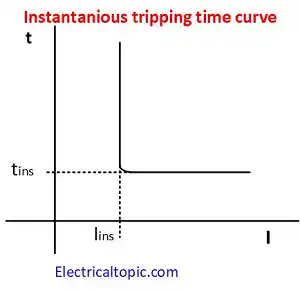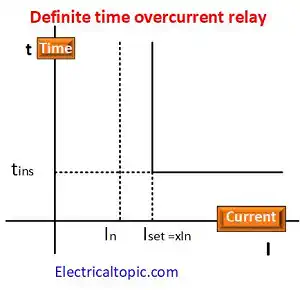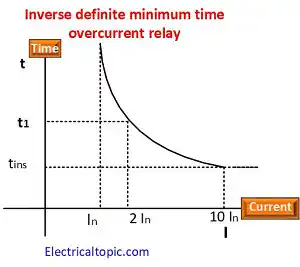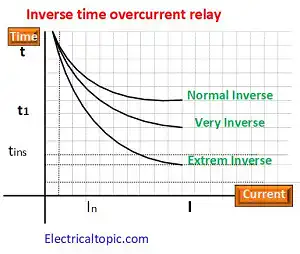Types of Over Current Relay
applications and characteristics.
1 - Over current relay Protection:
Over current relay is an element of relay which is operated after
crossing preset limit value of current and time then it provides
tripping signal to the circuit breaker tripping coil. It is really
current monitoring relay which is behave as per current condition.
Over current relay protects the electrical system like as
transmission lines, transformers, generators from short circuit,
overload, ground fault etc.
If the fault current value is extra high then it will trip
instantaneous or quick. So, this type over current relay can be
categorized in different types as per fault current value. Let’s
discuss about categories of over current relay.
2 - Types of over current relay protection.
HT panel protection relay are used according different types faults as over current, earth fault etc.
1 - Instantaneous over current relay.

Instantaneous over current relay is used for instant tripping for system protection. If the fault current is major then the tripping relay is activated without delay time. It means we can say the time is less during pick up value and relay closing contacts.
Important features
- It is known for fast operation speed during fault.
- Protection against high fault current.
- Relay operates instantly.
- Relay operating time is constant.
Applications
it is used for outgoing feeder in distribution system where the fault current can be high.
2 - Definite time over current relay.

Definite time over current relay is used with preset value of over current pickup value and operation time. If the current value is increases against preset value then it will take preset operation time for tripping. If the current value is decrease before completing preset time then the relay is not activated.
Important features
- Relay operation time is constant.
- It has time delay and pickup value setting. It can be set as per site requirement.
- it is depend on current magnitude.
Applications
it is used for outgoing feeders and bus cuppler in distribution system where the system load can be increase just second.
3 - Inverse definite minimum time (IDMT) over current relay

Its full name is inverse definite minimum time relay. The IDMT relay
is used where the operation time is proportional to the fault
current. The time of operation is adjusted in time delay setting.
it means if the fault is major then it will take minimum time
for tripping. If the fault current is not more than it will trip as
normal time. If the fault current is high then trip time will be
minimum. If the fault current is low then trip time is high or
adjustable as per requirement.
Important features
- Relay operation time is variable as per preset value.
- Inversely proportional to the fault current.
- It has time delay and pickup value setting. It can be set as per site requirement.
- it is depend on current magnitude.
Applicatins
it is used for outgoing feeder in distribution system where the system load is variable

A - Inverse time over current relay
Normal inverse type over current relay is used where the fault current is normal changes. It has an operating time depending on the value of the current with an inverse characteristic. The relay operation time is smaller if the current value is larger.
B - Very inverse time over current relay
If the relay inverse characteristic value is more than IDMT relay this type relay is called as very inverse. it is used where fault current magnitude is decrease rapidly because the source is far. It is used for sensing fault current location is far from source.
C - Extreme inverse over current relay
It has extreme characteristic value as compared to IDMT and very inverse relay. The relay can be operated instantly if the default current value is more as pickup value. It is faster in comparison of IDMT and very inverse relay. It is used for protection machines from overheat.